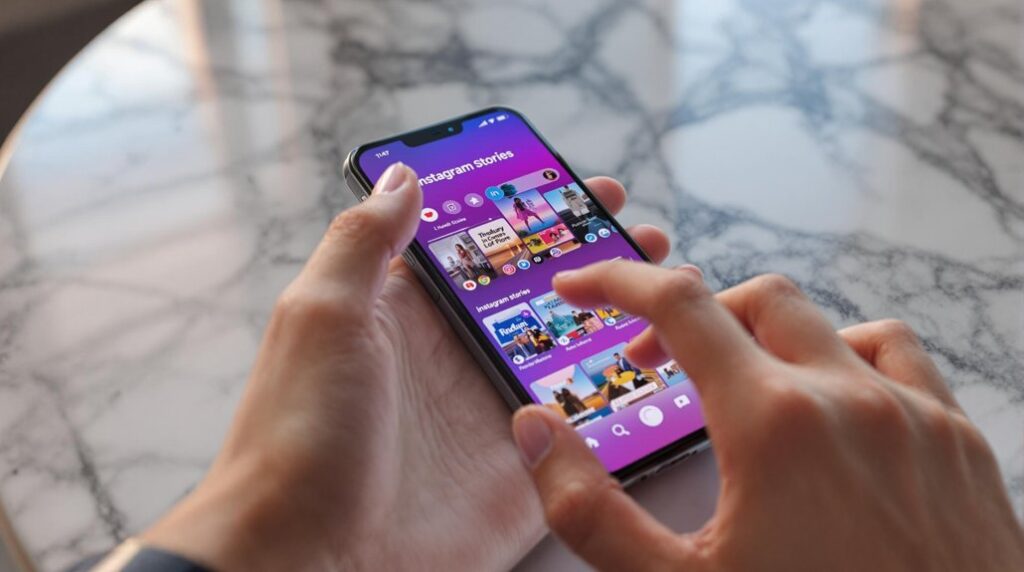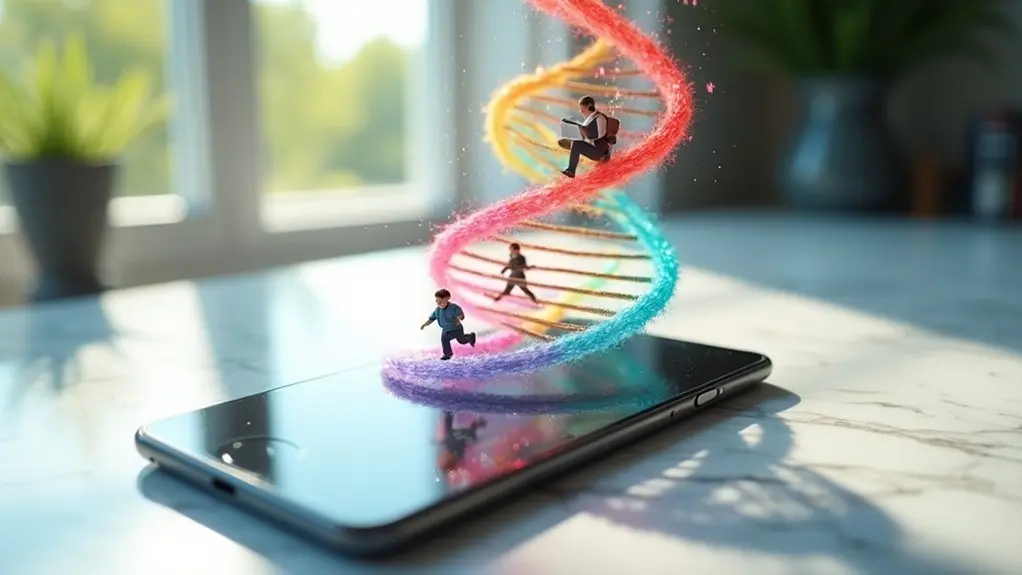Your Instagram campaign’s ROI is determined by evaluating key metrics such as engagement rates, click-through rates (CTR), audience growth, and brand awareness. These elements quantify the campaign’s efficacy and alignment with strategic goals. Calculating ROI involves measuring the value obtained against costs, using the formula: (Value achieved – Costs) / Costs x 100. Positive growth in metrics like CTR and conversions signals a successful strategy. Enhance reach through influencer marketing and user-generated content. Regularly analyze data to adjust tactics for sustained success. Exploring these factors further reveals thorough strategies for maximizing campaign impact.
Key Takeaways
- ROI is determined by the formula: (Value achieved – Costs) / Costs x 100.
- Engagement metrics like likes, comments, and CTRs impact Instagram campaign ROI.
- Audience growth rate quantifies follower increase, influencing campaign success.
- Brand reach and awareness, enhanced by organic impressions, determine campaign effectiveness.
- Assigning monetary values to conversions and engagement rates is crucial for accurate ROI measurement.
Understanding Instagram ROI
Understanding Instagram ROI is vital for businesses aiming to optimize their social media marketing efforts. Instagram ROI measures the value generated from Instagram marketing efforts relative to the investment made, encompassing monetary and non-monetary metrics. The ability to measure social media ROI is significant, as it directly influences strategic decisions regarding marketing budgets and campaign design.
Key metrics, such as engagement metrics, audience growth, and brand awareness, are essential in understanding ROI. These metrics align with business objectives, providing a thorough view of campaign performance. A positive growth rate in these areas signifies a robust social media strategy.
Moreover, engagement metrics like click-through rates and conversions are important for evaluating campaign efficacy. They offer insights into how well the content resonates with the target audience. Regular updates and analysis of these metrics are required to adapt strategies for continuous improvement.
As approximately 34% of marketers express uncertainty about measuring social media ROI, the need for clear goals and structured measurement techniques becomes evident. Ultimately, a well-calculated ROI helps businesses refine their social media strategy, ensuring that marketing initiatives are both impactful and aligned with overarching business goals.
Calculating Instagram ROI
Calculating Instagram ROI is a strategic process that hinges on accurately evaluating the monetary and non-monetary returns relative to the investments made.
To calculate Instagram ROI, the formula (Value achieved – Costs) / Costs x 100 is employed, where a positive ROI indicates a successful campaign. Social media marketers must assign monetary values to key metrics, such as engagement rate and conversions, to measure your ROI effectively. This involves differentiating between tangible metrics, like direct sales, and intangible ones, such as brand awareness and customer sentiment.
When calculating ROI, it’s critical to account for all costs to evaluate, including content creation, advertising budgets, salaries for social media personnel, and expenses for analytical tools.
These components are integral to understanding the complete picture of your marketing budget and subsequent ROI. Regularly revisiting these calculations allows for strategic adjustments, ensuring that your campaigns remain effective over time.
Importance of Reach
Evaluating the return on investment from Instagram campaigns requires a thorough understanding of various components, with reach standing out as a vital factor. Reach is integral to ROI, as it encompasses the breadth of audience exposure and engagement a campaign can achieve.
Organic impressions serve as a cornerstone, occurring when accounts mention or tag a brand, thereby enhancing brand visibility and potential reach. This visibility is important for expanding a brand’s audience beyond its immediate followers.
Influencer marketing plays a strategic role in amplifying reach. By leveraging influencers, brands can penetrate larger audiences, thereby boosting campaign effectiveness. Effective influencer partnerships result in increased brand visibility and engagement, contributing to a robust earned reach.
Earned reach is indicative of how well a campaign resonates with its audience, reflecting its success in driving engagement and organic growth.
Social media competitions are another effective tactic, greatly enhancing organic reach by encouraging user interaction and engagement. Through likes, follows, comments, and tags, brands can access wider circles of followers, further amplifying their reach.
Ultimately, a strategic focus on reach, including organic impressions and earned reach, is essential for optimizing Instagram campaign ROI.
Audience Growth Indicators
A pivotal metric in evaluating Instagram campaign success is the audience growth rate, which quantifies the percentage increase in followers over a designated timeframe. This indicator is essential as it reflects the effectiveness of outreach strategies and the impact of content engagement.
Analyzing new followers gained monthly serves as a strategic tool to discern which Instagram posts and campaigns resonate most with the target audience, fostering long-term growth. The ability to cultivate organic reach is also fundamental, as it underscores the content’s quality and its capacity to attract followers without resorting to paid promotions.
Monitoring high-quality followers, those who actively engage with content, is crucial for guaranteeing sustainable growth. These followers are more likely to convert into loyal customers, contributing considerably to the campaign’s overall success.
Aligning audience growth metrics with engagement rates becomes imperative; higher engagement typically enhances visibility, facilitating further organic follower acquisition. By strategically focusing on these metrics, brands can implement successful campaigns that not only increase their follower count but also improve the quality of their audience, ultimately boosting the return on investment (ROI) from Instagram initiatives.
This approach guarantees a robust and growing presence on the platform.
Engagement Metrics
Understanding engagement metrics on Instagram is essential for measuring the effectiveness of a campaign’s content strategy. These metrics, including likes, comments, shares, and saves, provide insights into how well content resonates with the audience. They are key indicators of campaign success, as they directly contribute to Instagram ROI.
Higher engagement rates, calculated by dividing total engagements by follower count, highlight a stronger audience connection. Such rates are favored by Instagram’s algorithm, enhancing visibility and potentially increasing reach.
Analyzing engagement metrics allows marketers to identify content strategies that elicit significant interaction. Posts with substantial comment volumes are particularly beneficial, as they not only demonstrate engaging content but also encourage deeper interactions. These interactions can transform followers into loyal customers, thereby boosting campaign effectiveness.
It’s significant that the average engagement rate varies by follower count; smaller accounts (around 1,000 followers) typically achieve 3-5% engagement, whereas larger accounts (100,000 followers or more) may see reduced rates of 1-2%.
Impact of Clicks
The impact of clicks on Instagram is a critical metric for evaluating campaign effectiveness, as higher click-through rates (CTR) correlate with successful engagement strategies and compelling content.
Strategically enhancing CTRs through optimized bios and targeted calls to action can greatly boost user interaction, leading to increased traffic to promotional sites and higher conversion potential.
Enhancing Click-Through Rates
Increasing click-through rates (CTR) on Instagram can greatly impact a brand’s online engagement and conversion metrics. A robust social media presence is vital for enhancing click-through rates, which in turn helps measure ROI effectively.
Key strategies include implementing engaging calls to action (CTAs) within posts, as they nudge users to interact with links found in bios or stories. Brands that articulate clear reasons for clicks, such as exclusive offers or valuable content, often see a notable uplift in both engagement and conversion rates, ensuring the audience is growing sustainably.
To streamline these efforts, utilizing tools you need, like Sked Link, can manage bio links more efficiently, directing users seamlessly to targeted campaigns or landing pages. An informative bio that highlights a brand’s unique value proposition is instrumental in driving traffic, as it serves as the first touchpoint for potential customers.
Additionally, incorporating user-generated content has shown to not only boost authenticity but also result in a 4X increase in clicks compared to traditional promotional content. By leveraging these strategies within organic social media practices, brands can strategically enhance their Instagram campaign’s ROI through improved click-through rates.
Driving User Interaction
Harnessing the momentum of clicks on Instagram is pivotal for brands seeking to translate social media engagement into tangible business outcomes. Clicks on Instagram serve as a critical metric for measuring potential conversions, indicating user interest in further actions such as visiting websites or completing purchases.
To optimize this, Instagram campaigns must focus on driving user interaction through engaging calls to action (CTAs) that notably enhance click-through rates (CTR). A strategic approach involves CTAs that prompt users to engage with content beyond passive viewing, effectively increasing the likelihood of interaction.
Brands can further bolster clicks by linking to competitions or events in their Instagram bios, leveraging these incentives to provide clear motivation for user engagement.
The effectiveness of these strategies is quantifiable; the CTR is calculated by dividing the number of clicks by total views, offering a clear measure of content efficacy.
To measure the ROI of Instagram campaigns, tracking clicks with Google Analytics or UTM parameters is essential. This approach provides insights into how Instagram efforts directly impact website traffic and conversions, allowing brands to refine their strategies and enhance overall campaign performance.
Building Brand Awareness
Amidst the evolving landscape of consumer behavior, Instagram emerges as a vital platform for building brand awareness. With 54% of users utilizing social media marketing to research products, Instagram’s potential for influencing purchase decisions is undeniable. To maximize Instagram influencer marketing ROI, brands must strategically improve their engagement and visual content.
- Leverage Hashtags: Posts incorporating at least one hashtag achieve 12.6% more engagement, essential for expanding organic reach and boosting brand awareness.
- Optimize Visual Content: Quality imagery is paramount, as 67% of consumers report that visual content greatly impacts their buying decisions. High-caliber content increases perceived brand value, driving potential conversions.
- Facilitate Customer Engagement: Consistent interaction on Instagram can raise customer engagement by 32%. This connection is fundamental in fostering deeper relationships and increasing brand visibility.
- Engage Through Activities: Hosting contests and competitions not only enhances organic reach but also encourages sharing and tagging. These tactics introduce the brand to new audiences, broadening its awareness footprint.
Measuring ROI in this situation requires a keen focus on engagement metrics and the conversion potential of these strategies.
Through targeted use of hashtags, compelling visual content, and consistent customer interaction, brands can strategically amplify their presence on Instagram, optimizing their journey from awareness to conversion.
Enhancing Brand Loyalty
Capitalizing on the emotional power of visual content, Instagram serves as a strategic tool for enhancing brand loyalty. By leveraging social media’s unique capabilities, brands can build lasting emotional connections with their audience.
Visual storytelling plays a pivotal role, as 56% of customers remain loyal to brands they find relatable, highlighting the importance of consistent and engaging narratives. This approach fosters deeper audience connections and cultivates a loyal following.
Incorporating user-generated content further strengthens these bonds. Brands utilizing such content witness a 4X increase in clicks, driving engagement rates and enhancing authenticity.
This community involvement not only boosts engagement but also solidifies brand loyalty by promoting a sense of belonging among followers. High engagement rates, evident through comments and shares, denote invested followers and improved brand affinity, turning loyal customers into brand advocates.
Direct lines of communication via direct messages and relatable content are instrumental in achieving loyalty gains, with 73% of consumers preferring to interact with brands on social media platforms.
Effective marketing campaigns on Instagram that prioritize these elements can greatly enhance brand loyalty, ultimately contributing to a more robust return on investment.
Frequently Asked Questions
How to Measure ROI on Instagram?
To measure ROI on Instagram, evaluate engagement metrics, conversion tracking, and audience insights. Analyze content performance, hashtag effectiveness, influencer partnerships, ad spend, click-through rates, customer lifetime value, and brand awareness for a strategic assessment of campaign success.
How Do You Determine ROI From Social Media Campaigns?
Determining ROI from social media campaigns involves analyzing engagement metrics, conversion tracking, and audience targeting. Strategic content strategy, clear campaign objectives, budget allocation, influencer partnerships, and performance analysis are essential for enhancing brand awareness and optimizing the customer journey.
What Is a Good ROI for Instagram Ads?
A good ROI for Instagram ads involves aligning target audience, ad formats, and campaign objectives while maximizing audience engagement through creative content. Strategic bidding strategies, performance metrics, and adherence to seasonal trends and industry benchmarks optimize ad spend effectiveness.
What Is the Average ROI for Instagram?
The average ROI for Instagram campaigns is influenced by factors such as Instagram engagement, audience demographics, content strategy, and influencer partnerships. Key elements include ad formats, campaign objectives, brand visibility, customer acquisition, conversion rates, and industry benchmarks.
Conclusion
The determination of an Instagram campaign’s ROI hinges on multiple factors including reach, audience growth, engagement metrics, click impact, brand awareness, and brand loyalty. Quantifying ROI necessitates a thorough analysis of these variables, as they collectively influence the campaign’s effectiveness in meeting strategic objectives. A data-driven approach, integrating both quantitative and qualitative metrics, provides a nuanced understanding of the campaign’s success. Strategic adjustments informed by these insights can optimize future campaigns, ensuring alignment with overarching marketing goals.




